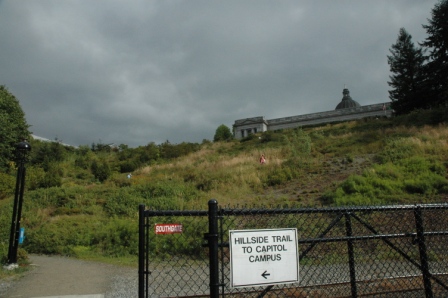Last month Linda posted on the need for horticultural knowledge for those trying to restore native habitats or at least establish native plants. There seems to be a pervasive notion that if we plant natives all we have to do is stick them in the ground and walk away. They’re native, right? Don’t need irrigation; don’t need fertilizer; all that good jazz. Well, often there is lot more to it than that.

A case in point. Over the past couple of years I’ve been watching an unintended experiment near the State Capitol grounds in Olympia, WA. The State opened up a vista so that the south end of Puget Sound and the Olympic Mountains were visible from the Capitol campus. It’s a lovely view. As part of the development, a switchback trail was established on the steep hillside to connect the Capitol grounds with the park surrounding Capitol Lake below. A great idea. Along the trial the hillside was planted with an array of native plants such as Oregon grape, salal, alder, and western redcedar. Another fine idea. Now comes the problem. Near as I can tell, there was no plan for maintaining these native plants. In fairly short order the hillside has become overrun with grasses, dandelions, and Himalayan blackberries – not exactly the desired effect. And therein lies the rub. Everyone is on board to plant natives but who’s on board for the hard work to maintain them. Keeping weedy species from this planting by hand would take an army volunteers. Burning is likely out due to the proximity of the Capitol and probably wouldn’t promote the desired species. The answer? Most likely a combination of hand-weeding and herbicides. It is interesting that when the end justifies the means, herbicide is not such a dirty word anymore. So there you go. In order to effectively establish and maintain native plants, not only do we need to know about Mahonia aquifolium, Gaultheria shallon, and Alnus rubra; but it also helps to know about glyphosate, flumioxazin, and triclopyr.
You go, Bert! It also helps to use a LOT of mulch during installation. You can keep many of the weeds at bay for the first few critical years if you mulch well with a thick layer of coarse woody mulch. It certainly decreases the amount of maintenance needed.
I work in a field that sees me do the odd restorative ecology job. We always tell the clients we work for (often local councils or government water resource bodies), that planting an area is one thing, but maintaining it is the critical part. It seems getting funding for ongoing management of revegetated areas is the critical part – most government departments’ budgetary concerns have a lifespan of a single financial year, and the ongoing maintenance needs of restored areas often falls by the wayside.
People often say to me, “It must be lovely to restore an area’s indigenous flora and watch it grow.” To which my response is that it works both ways. It can be very rewarding, but it can also be equally as frustrating when you see all your hard work dashed with encroaching weed species. Thanks to the hand of the economic rationalists sitting behind a desk some 30 miles away, dealing out the year’s dough, I’ve seen several medium sized restoration projects go to pot.
Interestingly, the use of mulch in some areas of SE Australia in revegetation projects can be a hinderance. Australia naturally has a predominance of impoverished, heavily weathered soils. The use of mulch on which can increase the nutrient levels in the extant soil so much so that weedy species that would never have grown in the area suddenly become a problem. It’s a tricky one in these parts.
I can relate to the weed enhancement issue, Jimbo. Even in my own neighborhood I see people put down either compost (a weed magnet) or a 1-2″ layer of chips. Neither of these will suppress weeds and instead serve to nourish them. In the literture review I did a few years back the critical characteristics were depth (at least 4″ over time) and coarseness (chunkier is better). We generally use about 12″ of chips so that we get 1-2 years of critical depth.
Maintenance is the big issue! You can plant whatever you want, but unless you’re planting some incredibly aggressive and conceivably invasive species, what you put in has to be taken care of while it gets established, and beyond. Maintenance is the toughest thing to sell, though; capital improvements (especially when you can tag them as being part of the trend du jour) make a big splash for any organization funding them, and so are eminently fundable — but the idea of paying for the maintenance of newly planted places unfortunately lacks the sexiness of paying for a new installation. And as Jimbo points out, knowing how to maintain a given set of plants in a given place adds a whole ‘nother layer of complexity to the ‘selling’ and funding of a maintenance effort. Great post!
What thought provoking comments. I would like to add, that herbicides should be a last resort and employing your Master Gardener Program to maintain a restored area is a viable option. Here in Chicago, there are several projects that are successful because of the MG involvement. Funding, however, has become a bit dicey.
Oh, we’ll get volunteers to maintain it. Hah!
Great post! I don’t know who benefits from this, but it does seem like native plants are being “sold” as no-care. Like all plants, it depends. Some of them aren’t even “easy-care.” Just because they’re native, doesn’t mean they are easy to grow.